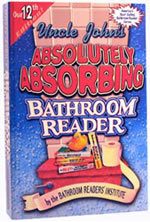Fat Chance: The War Between Butter and Margarine
 The following is an article from the book Uncle John's Absolutely Absorbing Bathroom Reader.
The following is an article from the book Uncle John's Absolutely Absorbing Bathroom Reader.
These days, you expect to find both butter and margarine on grocery shelves… but did you know that margarine companies had to fight to get there? This article was written by Jack Mingo.
MARGINAL USE
“Oleomargarine” was a word coined in the late 1860s by a French chemist, Hippolyte Mège-Mouriès. The price of butter had soared, so Napoleon II, expecting shortages because of an anticipated war with Prussia, offered a prize at the Paris World Exhibition in 1866 to anyone who could come up with a cheap, plentiful butter substitute.
Mège-Mouriès did some research and discovered that even starving cows give milk containing milk fat. Since this fat isn’t coming from their food, he reasoned that it must be coming from the cows themselves. Deciding that it must be possible to do the same thing mechanically, he invented a process to render oil from beef fat and combine the oil with milk to form a butter-like spread. He won Napoleon’s prize, but lost the first marketplace skirmish- his margarine factory opened in 1873 near Paris, then had to close when peace unexpectedly broke out and ruined the expected butter shortages.
ACROSS THE OCEAN
Mège-Mouriès’ process, however, found a home in the United States. The U.S. Dairy Company bought the rights to it in 1874 and licensed the process to 15 factories around the country. By 1882, it was making 50,000 pounds of the imitation spread every day. Soon, Armour and other meat-packing houses began producing margarine of their own, using fatty by-products left over from meat processing.

Farmers and butter manufacturers were beginning to get worried by this new product, especially those who made cheaper, lower-grade butter. Margarine was roughly comparable in price, but it was often of better quality.
In 1877 the dairy industry engineered the passage of laws in New York and Maryland requiring that oleomargarine “be marketed, branded, and stamped as such, under penalty of $100 and imprisonment for 30 days.” Even the margarine manufacturers agreed that that these laws were reasonable, and didn’t object when other states followed suit. In the words of a spokesman in 1880, “Of course, this had for a time its effect upon the sale of the product; but as oleomargarine is a pure and wholesome article of food, possessing all the qualities of good dairy butter, the people have overlooked the name and have decided to eat it.”
GOING FOR THE JUGULAR
But that wasn’t enough for the dairy interests. Ironically -since farmers of the time were notorious for extending and whitening milk and cream with water, chalk, magnesia, and even plaster of Paris- the dairy concerns created new organizations like the National Association for the Prevention of Adulteration of Butter, to combat the “adulteration and risk to health” supposedly posed by margarine. In lurid anti-margarine propaganda, the dairy interest featured slanderous tales of repulsive ingredients used to make “bogus butter.”

“The slag of the butcher shop,” they called margarine, “a compound of diseased hogs and dead dogs” that contained “the germs of cancer and insanity.” They paid one Professor Piper, a mysterious researcher with dubious credentials, to do an imaginative “study” in which he found in samples of margarine “many kinds of living organisms, dead mould, bits of cellulose, shreds of hair, bristles, etc., doubtful worms, corpuscles from a cockroach, small bits of claws, corpuscles of sheep, the egg of a tapeworm, a dead hydra virus…”  The margarine companies tried to defend themselves. But while the president of the New York Board of Health spoke of margarine’s purity at their behest, dairy lobbyists in Maine, Michigan, Minnesota, New York, Ohio, Pennsylvania, and Wisconsin rammed through legislation that banned “any article designed to take the place of butter.” By 1885, two-thirds of all margarine manufacturers in those states had gone out of business.
The margarine companies tried to defend themselves. But while the president of the New York Board of Health spoke of margarine’s purity at their behest, dairy lobbyists in Maine, Michigan, Minnesota, New York, Ohio, Pennsylvania, and Wisconsin rammed through legislation that banned “any article designed to take the place of butter.” By 1885, two-thirds of all margarine manufacturers in those states had gone out of business.
After court challenges in New York and Maine, courts ruled that the laws were too broad. The New York ban was ruled unconstitutional on the grounds that the unwholesomeness of margarine was not demonstrated and, “without pervasive evidence, the government could not prohibit the whole industry just to protect another.” The Supreme Court struck down the rest of bans in 1894, while suggesting an alternative: Since it was the color of margarine that led to fraud, states could ban colored margarine, while letting uncolored margarine be sold freely.
SLIPPERY MANEUVERS
Once again, dairy concerns rammed through laws- this time convincing 30 states, by the turn of the century, to ban colored margarine. (Ironically, the butter makers themselves routinely added annatto to their butter to make it more yellow.) Pallid off-white was an unappetizing color, and margarine sales went down again. But not down far enough of rate butter lobby. They pushed harder, getting laws passed in five states that required margarine producers to dye their product pink. Not surprisingly, sales in those states plummeted.

In 1902 the butter industry persuaded the federal government to get into the act as well, slapping a 10¢ tax on artificially colored margarine. This effectively increased the price to the consumer by 50%, making it more expensive than most grades of butter. In response, the margarine manufacturers began using vegetable oils for margarine -especially those with a natural yellow hue. It gave the margarine some color without incurring the tax. By World War I, the vegetable-based margarine dominated the market.  In 1931 the government closed the tax loophole of allowing naturally-colored oils by taxing all yellow margarines, whether colored artificially or not. Margarine makers found a way around that law, too. They discovered that it didn’t prohibit consumers from dying their own margarine.
In 1931 the government closed the tax loophole of allowing naturally-colored oils by taxing all yellow margarines, whether colored artificially or not. Margarine makers found a way around that law, too. They discovered that it didn’t prohibit consumers from dying their own margarine.
So they provided a yellow “color capsule” free of charge with every purchase of margarine. When consumers got the margarine home, they massaged the dye around inside the cellophane package of margarine until it was a uniform golden color. While this was a minor inconvenience for consumers, margarine sale began to creep up again.
GOTCHA!
Finally margarine got a chance to fight back. During the financial insecurity of the Depression and butter rationing of World War II, consumers flocked to margarine, which was no longer perceived as a low-class, disreputable spread of dubious origin. Many consumers discovered they preferred the economy and even the taste of margarine to that of “the high priced spread,” (as margarine ads called butter). And consumers began wondering why they had to put up with the mess of coloring their own margarine at home. Finally in 1950, pushed by vegetable oil producers, labor unions, and consumers, Congress narrowly passed a law to rescind the federal tax on colored margarine. States began following suit. Within five years, every state except Minnesota and Wisconsin had repealed such laws. (Minnesota held out until 1963; Wisconsin, “the Dairy State,” until 1967.)
Finally in 1950, pushed by vegetable oil producers, labor unions, and consumers, Congress narrowly passed a law to rescind the federal tax on colored margarine. States began following suit. Within five years, every state except Minnesota and Wisconsin had repealed such laws. (Minnesota held out until 1963; Wisconsin, “the Dairy State,” until 1967.)
FAT IS FAT
In the 1960s and 1970s, the margarine market suddenly pulled ahead of butter as health-conscious consumers began avoiding animal fats, based on studies that concluded that margarine was less artery-clogging than butter.
But it turned out that the studies were wrong. More recent research showed that hydrogenating vegetable oil to make it semi-solid created “transfatty acids” that act like saturated fats, raising blood cholesterol levels.
As that word got out to consumers, margarine sales dropped 8% in 1994, while butter sales went up 5.3%. Margarine makers, by now resigned to changing their product every few years to match the vagaries of life, law, politics, and consumer demand, scrambled to come up with formulations that tasted good and were free of transfatty acids.
After a century and a quarter, the war between butter and margarine isn’t over.
_____________________________
 The article above is reprinted with permission from Uncle John's Absolutely Absorbing Bathroom Reader, a fantastic book by the Bathroom Readers' Institute.
The article above is reprinted with permission from Uncle John's Absolutely Absorbing Bathroom Reader, a fantastic book by the Bathroom Readers' Institute.
Since 1988, the Bathroom Reader Institute had published a series of popular books containing irresistible bits of trivia and obscure yet fascinating facts. If you like Neatorama, you'll love the Bathroom Reader Institute's books - go ahead and check 'em out! 
We hope you like this article!
Please help us grow by sharing:
Get Updates In Your Inbox
Free weekly emails, plus get access
to subscriber-only prizes.
















http://www.youtube.com/watch?v=0MsbvGmLaU4